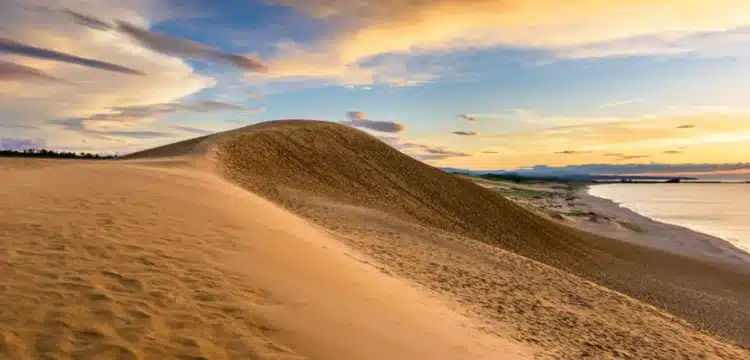[vc_row][vc_column][vc_column_text dp_text_size=”size-4″]Sprawling mounds of golden sand rise in peaks towards the scorching sun. A beautiful blue sky peeks out from beyond the enormous expanse from the base of the desert’s biggest dune.
You could easily believe you’d landed in the Middle East. The Tottori Sand Dunes, however, lie jammed along the coast of Japan’s thinly inhabited San’in area, the country’s very own piece of desert.
The dunes stretch for 16 kilometres (10 miles) along the coast, with the tallest peaks rising more than 45 metres (150 feet). They’ve been present for thousands of years, but are progressively fading due to community efforts to conserve the planet, not climate change.
A vanishing treasure
The Tottori sand dunes are located on Honshu, Japan’s largest and most populous island.
Tottori is Japan’s smallest prefecture. Osaka is around 200 kilometres (124 miles) distant, and Hiroshima is about 300 kilometres (186) miles away.
The dunes formed over 100,000 years as sand was transported from the adjacent Chgoku Mountains via the Sendai River and dumped in the Sea of Japan. Wind and currents pushed the sand back onto the beach over time.
The dunes were mostly unknown outside of Tottori until 1923, when they appeared in the writings of great Japanese poet Takeo Arishima, sparking their rise to tourism prominence.
The dunes are now an important part of Tottori prefecture’s tourism business, attracting an average of 1.2 million visitors every year. Tourists can go sandboarding and ride camels, as well as visit a Sand Museum.
The dunes provide millions of dollars in tourism revenue each year, but there’s a catch: they’re receding. Tottori Sand Dunes are only 12% the size they were 100 years ago.
This is due to a hugely successful afforestation, or tree planting, initiative that was conducted across Japan at the end of WWII. The Tottori effort attempted to convert dunes into forest and farms in order to feed the community, prevent sandstorm damage, and better care for the environment.
“Many pine trees have been planted on coastal dunes throughout the Japanese archipelago to stop flying sand,” adds Dr. Dai Nagamatsu, a vegetation science professor at Tottori University who undertakes dunes research.
“Coastal forests had been developed, particularly in the twentieth century, when technology was more advanced.” Because of the success of the plantations, many coastal dunes were transformed to fields and residential areas near the ocean, and the dunes vanished.”
Tottori City, the prefecture’s capital, was even built on top of some of the afforested dunes.
When the afforestation initiative took underway, academics and tourism operators urged the town to retain portions of the desert for economic and scientific reasons.
Local officials agreed and designated 395 acres of the dunes’ most rough area – the 12% that remains – as a protected national park.
Rebuilding the desert
When the community realised the magnitude of the dunes’ loss, they set out to bring them back to life, but the foliage had already set out on its own journey.
Efforts to clear the trees that had encroached on the desert proved difficult in 1972. Once plant species were introduced to the area, they continued to return, choking the sand of the unrestricted mobility that generated the iconic ripples.
Scientists have been battling the shrinking desert since vegetation began to emerge in sections where the burnt forest had been.
Perhaps it is not surprising that Japan is so proficient at afforestation that it has become an international export.

Can tourism and conservation coexist?
It’s natural to believe that allowing the dunes to revert to grassland would be healthier for the environment, but has the local administration been more environmentally conscious than its economic interests require?
Many scientists believe that the dunes’ unique circumstances make them worth conserving. Scientists from all around the world perform dryland agriculture research at Tottori University’s Arid Land Research Centre.
“Because of the humid climate, the environmental conditions of the Tottori Sand Dunes differ from those of arid lands,” Nagamatsu explains. “However, Tottori University promotes arid land research by utilising the’sand’ conditions of the Tottori Sand Dunes as well as experimental facilities.”
Tourists are having an unreal adventure in the sand just down the road from the research centre.
On a typical weekend at the dunes, people linger around gift shops, painstakingly wrapping omiyage (gift-worthy trinkets) to bring home to friends.
They purchase delightful powdered-sugar ginger “sand cookies,” visit the local sand museum, and indulge in soft-serve pear ice cream. Camels are available for paid photo opportunities outside the dunes’ main entrance, and a local shop gives brief “rentals” of time with their shiba inu dog, who is glad to romp with tourists on the hills.
Wind conditions are closely monitored by paragliders and sandboarders in search of the ideal moment. Stargazers can get glimpses of the dunes’ foxes, rabbits, and tanuki (Japanese racoons) at night.
“When I first went to Tottori Dunes, I was very happy,” says Anya Jarilla, who visited the dunes for the first time last year. “I can’t believe a place like that exists in Japan…”To experience and see the place is beyond my imagination.”
Tourists often claim they feel like kids again when they visit the Tottori Sand Dunes Visitor Centre, sprinting down slopes at full speed and marvelling at the sand’s ever-changing formations, according to staff at the Tottori Sand Dunes Visitor Centre.
Visitors can reach the dunes by taxi or bus from Tottori Station. The dunes are within walking distance of shops and museums, which are open until mid-afternoon. The dunes themselves are open 24 hours a day and are free to visit. Tottori City, about a 10-minute cab ride from the dunes, has a variety of inexpensive hotels and ryokans (traditional Japanese inns).
Tottori is Japan’s least populous prefecture, located far from the crowded bullet train lines that connect travellers to the country’s most popular towns and sites. Getting there from Tokyo takes a transfer from the bullet train to a local train line, a domestic flight or a long drive – but the dunes are worth the effort.
The national monument is a literary treasure and a valuable study site, but it is also a financial anchor.

Striking a balance
One fundamental question remains: how can the region increase tourism without permanently harming the dunes?
Virtual and augmented reality have been proposed as potential solutions for increasing tourism revenue while responding to visual changes and preserving the dunes. During the height of Pokemon Go in 2017, the game’s makers held a special weekend inviting users to catch digital desert Pokemon in the sand.
In 2022, the Tokyo-based business amulapo presented an in-person augmented reality experience that recreated a moonwalk on the dunes, complete with the planting of a flag on the “lunar surface.”
Concerns about the dunes persist in the non-digital world. However, local business leaders are committed to continue promoting the area to the best of their abilities.
Just last year, one of the area’s hottest local businesses opened in the dunes: a stunning cafe designed by the famed architects of Kengo Kuma and Associates to seem like a “staircase to the sky.”
Some experts even predict that as the climate continues to change, the pendulum may swing towards dune restoration rather than afforestation as a more powerful protective measure. “Considering the tsunami damage that is likely to occur in Japan in the near future,” Nagamatsu says, “there appears to be room to reconsider current coastal land use and consider restoring natural dunes to Japan’s coasts.”
Perhaps one day, the dunes’ immensity will loom larger than life once more. For the time being, visitors and residents alike will continue to weed – as well as research, reserve, and defend – to keep this little desert sandy.[/vc_column_text][/vc_column][/vc_row]











